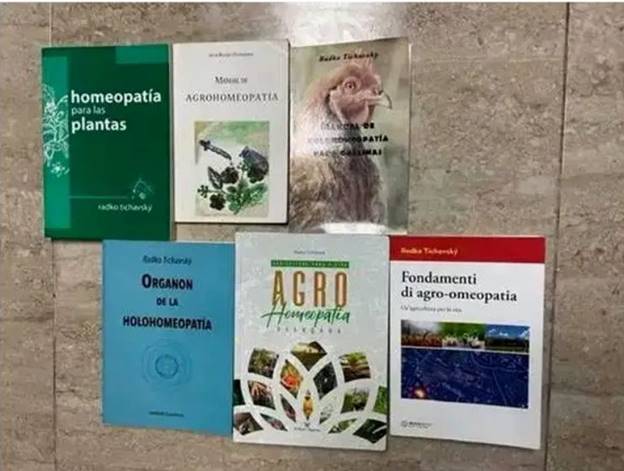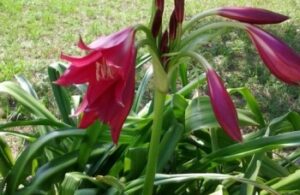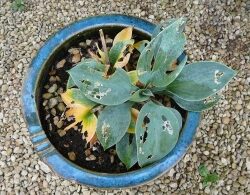Editor’s note: “JT potency” (Jenichen /Tichavsky) is a centesimal dilution followed by 500 succussions or five hundred continuous turns with a wooden stick to the right and 500 turns to the left (if handling larger volumes). The JT potency frequently has a better reaction in plants and it is very important in preparation of live bionosodes.
Dear Dr. Tichavsky,
I am a backyard gardener in Buffalo New York. The temperature is moderate. seldom in the teens .and seldom venturing into the nineties. I try to grow a lot of onion. Could you suggest a way to interfere with the onion maggot fly (Delia antiqua) from laying its eggs?
Also, the online advice suggests using lots of nitrogen but you mainly advise to minimize nitrogen. So, how could I fertilize the onions?
Thank you for your valuable advice.
Rodney Galarneau
Dr. Radko Tichavsky:
Dear Rodney,
To control the Delia antiqua, an integrated approach is recommended, including entomopathogenic nematodes from the genera Steinernema and Heterorhabditis. These nematodes actively seek out Delia antiqua larvae, infect them, and kill them.
Steinernema feltiae actively searches for and penetrates the fly larvae, causing their death within 3-7 days. Steinernema carpocapsae can survive in the soil for several weeks and performs the same ecological function. Heterorhabditis bacteriophora forms a symbiosis with bacteria from the Photorhabdus spp. genus, which causes septicemia in the larvae. The application of these entomopathogenic nematodes is preferably done at night.
A second alternative involves the application of homeopathic remedies that repel and act as insecticides. These include Allium sativum 3 JT, Azadirachta indica 3 JT (its bitter principles act as antifeedants and repellents, inducing larval mortality), Capsicum spp. 3 JT (containing capsaicinoids with a deterrent and toxic effect against both adults and larvae of the fly), Cinnamomum cassia 3 JT (antifeedant and larvicidal against the pest), Eucalyptus globulus 3 JT (made from essential oil) contains eugenol, citronellal, and geraniol which are repellent and insecticidal. Mentha piperita 3 JT (made from essential oil) reduces oviposition and adult emergence of the onion fly.
Regarding nitrogen fertilization, onions obviously require nitrogen, but it should be noted that this element constitutes about 78% of the air in the Earth’s atmosphere. Mostly, this nitrogen is in the form of diatomic gas (N₂), an inert and non-reactive molecule under normal conditions. This means that although nitrogen is abundant in the atmosphere and essential for life, it cannot be directly utilized by most plants.
Onions prefer nitrogen in “fixed” or “reactive” forms, such as nitrate (NO₃⁻), which can be absorbed and used to synthesize proteins and other vital compounds. Nitrogen-fixing bacteria, rhizobacteria, have the ability to convert atmospheric inert nitrogen into reactive forms that plants can use, known as nitrogen fixation.
Azospirillum brasilense, for example, can fix nitrogen within a temperature range that generally favors temperate to warm environments (10-30 degrees Celsius). Other nitrogen-fixing rhizobacteria like Azotobacter chroococcum (adapts to a wide variety of environmental conditions) or Rhizobium and Bradyrhizobium form nodules on the roots of legumes to fix nitrogen. Pseudomonas extremaustralis and Methylocella silvestris are capable of fixing nitrogen even at low temperatures. Non-rhizobial bacteria such as Arthrobacter and Bacillus, especially Bacillus amyloliquefaciens, can also participate. It is important to choose nitrogen-fixing bacteria that withstand the specific conditions of each holon.
Temperature Ranges for Various Bacteria:
- Azospirillum brasilense: 20-30°C
- Herbaspirillum seropedicae: 20-30°C
- Azotobacter chroococcum: 20-35°C
- Klebsiella pneumoniae: 20-37°C
- Pseudomonas stutzeri: 20-30°C
- Gluconacetobacter diazotrophicus: 20-30°C
- Rhizobium leguminosarum: 20-30°C
- Sinorhizobium meliloti: 20-30°C
- Mesorhizobium loti: 20-30°C
- Bradyrhizobium japonicum: 20-30°C
- Phyllobacterium myrsinacearum: 20-30°C
- Burkholderia vietnamiensis: 20-30°C
- Pseudomonas extremaustralis: up to 10°C
- Rhizobium etli: 10-30°C
- Rhodopseudomonas palustris: 5-35°C
- Methylocella silvestris: from 5°C
- Methylocapsa aurea: at low temperatures
- Frankia: from 5°C
Common ruderal species in the New York area contain nitrogen-fixing rhizobacteria beneficial for onion crops. For example, White clover (Trifolium repens) is associated with Sinorhizobium meliloti and other rhizobia, Alfalfa (Medicago sativa) also symbiotizes with Sinorhizobium meliloti. White mustard (Sinapis alba) collaborates with Pseudomonas and Azospirillum N fixers, Birdsfoot trefoil (Lotus corniculatus) its rhizosphere hosts rhizobia such as Ensifer meliloti. Wild peas (Lathyrus spp.) are colonized by Rhizobium leguminosarum and other bacteria, Red clover (Trifolium pratense) is also associated with Rhizobium leguminosarum.
You can extract some roots from one or several of these plants, wash them in unchlorinated water and prepare a 2 JT live bionosode to inoculate the bacteria into your onions. This way, you won’t need to fertilize with purchased nitrogen, allowing the bacteria to do the fertilization work for you.
In the roots of English ivy (Hedera helix), you’ll find and can extract Bacillus myloliquefaciens in the same way, a bacterium capable of fixing nitrogen and making phosphorus available to your onions. They will do it for free and very efficiently. Best regards!
Hi Dr. Tichavsky,
I’m attempting to grow cucumbers. The plants are growing but not producing any male flowers. Plenty of females with fruiting flowers but absolutely no male flowers, so I cannot hand pollinate. Is there any way to remedy this situation? The crop is in Lake City, Florida, U.S. Zip: 32024. Temperature ranges from 58 – 86 F. Average annual rainfall is 53.7 inches.
Thank you
Frederick
Dr. Radko Tichavsky:
Dear Frederick,
It is uncommon for cucumber plants not to produce male flowers, as these are generally the first to appear. However, there are some possible causes and solutions you might consider. Deficiencies or toxicity of some nutrients, especially Boron, can inhibit the formation of male flowers. In soils with high nitrogen content, the plants tend to produce only leaves instead of flowers. A lack of calcium also reduces the formation of male flowers.
Very high levels of potassium in the soil can disrupt the absorption of other nutrients and cause a lack of flowers. Manganese toxicity interferes with the absorption of calcium and can inhibit flowering. A magnesium deficiency also reduces the number of male flowers.
Excessive or insufficient watering harms the normal formation of flowers. If the temperature is above 86°F (30°C) during the day, try providing partial shade or increasing ventilation to reduce heat stress. At night, if the temperature drops below 58°F (14°C), consider covering the plants with a light cloth to keep them warmer. Some cucumber varieties are more prone to produce predominantly female flowers initially. Make sure you have selected a variety suitable for your region and growing conditions.
You can apply Magnesium carbonicum 6 CH, Borax 6 CH, and especially Gibberellic acid (GA3) at a potency of 3 JT. Foliar applications of GA3 at 3 JT potency between 6-8 weeks after sowing can significantly increase the number of male flowers. GA3 at this potency (3 JT) is effective as a biostimulant for male flowers without affecting the number of female flowers.
Dear Dr. Tichavsky,
Last year we experienced bacterial blight on our parsnip crop. We researched it and it is caused by Pseudomonas marginalis. It affected the petioles and other portions of the plants. Is there a way we can avoid that next season? We live in Hillsborough, Florida (U.S. 33603) that has a humid subtropical climate, with hot summers and mild winters. Rainfall averages of 50 inches per year.
Thank you
Greta
Dr. Radko Tichavsky
Dear Greta,
To keep Pseudomonas marginalis under control in Pastinaca sativa crops, it’s crucial to maintain soil biodiversity as various bacteria and fungi are antagonistic to Pseudomonas marginalis.
For example, Pseudomonas fluorescens colonizes plant roots and competes with pathogens like Pseudomonas marginalis for resources and space. Additionally, some strains of P. fluorescens produce antibiotic compounds that inhibit the growth of other pathogens.
This bacterium is found in various fungi, for instance, Laccaria laccata, Agaricus bisporus, or Lentinus edodes commonly. You can create a hydrolate from one of these fungi to obtain an inoculum of Pseudomonas fluorescens or purchase it online.
Bacillus subtilis has shown antagonistic activity against a variety of plant pathogens, including some Pseudomonas species. It produces a wide range of antimicrobial compounds that can inhibit the growth of pathogenic bacteria.
Streptomyces griseus has also shown antimicrobial activity against Pseudomonas marginalis.
Pseudomonas putida (found in Sonchus arvensis and many other ruderal plants) also colonizes plant roots and competes with Pseudomonas marginalis for nutrients and space. Stenotrophomonas maltophilia, Serratia plymuthica, Lysobacter enzymogenes, and Pseudomonas chlororaphis are some of the antagonist bacteria.
The fungus Trichoderma asperellum is also an important antagonist of Pseudomonas marginalis.
Regarding the homeopathic treatments we use, notable ones include Rosmarinus officinalis (sharing 101 metabolites with parsnip) which contains a significant amount of 1,8-cineole, potent not only against Pseudomonas marginalis but also against many other Gram-negative bacteria.
Thymol and gallic acid, both found in the essential oil of Thymus vulgaris (sharing 22 metabolites), are bactericidal against P. marginalis, acting on the cell membrane.
Carvacrol interferes with the energy metabolism of P. marginalis, inhibiting its growth. It is found in Origanum vulgare (sharing 51 metabolites with parsnip), which also contains 1,8-cineole.
Citrus limon (sharing 54 metabolites with parsnip) has a large amount of linanol in the fruit peel pericarp. Like carvacrol, it alters the permeability of the P. marginalis membrane.
Coumarins, polycyclic metabolites abundant in Ruta graveolens, are potent antibiotics against various strains of P. marginalis.
Catechins, polyphenols present in green tea and other Camellia sinensis, have bacteriostatic action combined with membrane disruption against this bacteria.
Allicin, a minor component of garlic (Allium sativum) with high bactericidal activity against P. marginalis, blocks DNA replication.
Gallic acid found in plants of Camellia sinensis (sharing 15 metabolites with parsnip) and also in Hamamelis virginiana (only two metabolites in common with parsnip) interferes with the motility and chemotactic response of P. marginalis, inhibiting colonization.
Cinnamomum verum (sharing 49 metabolites with parsnip) contains potent metabolites against Pseudomonas marginalis: 1,8-cineole, and proanthocyanidins.
In summary, you can alternate these remedies in potencies between 3 and 4 JT or even apply them together in a spray form.
A common combination is: Rosmarinus officinalis 3 JT (from the essential oil) Thymus vulgaris 3 JT (from the essential oil) Origanum vulgare 3 JT (from the essential oil) Citrus sinensis 3 JT (from the mother tincture of the pericarp) Camellia sinensis (from the mother tincture of the leaves)
Hello Dr. TIchavsky,
Three years ago our spinach crop was infected with Spinach downy mildew (Peronospora farinosa f.sp. spinaciae). We changed crops the next two years, but we would like to grow spinach again. Our crops are in Tompkins County in Ithaca New York (U.S.) The Ithaca climate is a warm-summer humid continental climate. Summers are warm but very short and it is cool-to-cold the rest of the year.
Thank you
Gregory
Radko Tichavsky:
Dear Gregory,
You have done well in rotating crops for two years. Rotation prevents the buildup of specific pathogens in the soil for any one crop. The next step is to choose a variety of spinach that is resistant to downy mildew, such as ‘Crosstrek’, ‘Trailboss’, ‘Sportage’, ‘Traverse’, ‘Frontier’, ‘Acadia’, ‘Tundra’, ‘Corvair’, and ‘Shelby’, among others. Each variety offers resistance to different races of the pathogen Peronospora farinosa f. sp. spinaciae.
Ensure that the plants have enough space between them to promote good air circulation and reduce moisture on the foliage, which can decrease the risk of mildew. Use drip irrigation instead of sprinklers to avoid wetting the leaves, as moisture promotes disease development.
Regarding homeopathic remedies, we use Sulphur 6 CH, Allium sativum 4 JT (from essential oil), Equisetum arvense 4 JT, Cinnamomum camphora 4 JT (made from essential oil), Symphytum officinale 4 JT, Camellia sinensis 4 JT, or Carum carvi 4 JT (from TM of the seeds). In this case, we use Azadirachta indica oil as an adjuvant
Online Diploma in Agricultural HoloHomeopathy (in English)
Transform your approach to farming with the Online Diploma in Agricultural HoloHomeopathy! This 6-month, fully online program is designed for farmers, agricultural professionals, and sustainability enthusiasts looking to implement effective, natural, and environmentally friendly farming practices. Duration: 6 months Mode: Online
Start Date: May 6th 2024
What You Will Learn:
- Foundations of Agricultural HoloHomeopathy: Discover how this practice improves soil health and crop productivity and resilience to climatic changes.
- Natural Pest Control: Learn to manage pests and diseases using homeopathic preparations, protecting biodiversity and avoiding harmful chemicals.
- Soil Fertility and Biodiversity: Enhance soil structure and promote a richly biodiverse environment with sustainable techniques.
- Concrete Results and Success Stories: Study real cases where Agricultural HoloHomeopathy has transformed farming practices, validating its effectiveness and benefits.
Diploma Benefits
- Certification: Obtain a certificate validating your knowledge and skills in Agricultural HoloHomeopathy.
- Taught by Dr. Radko Tichavsky, the diploma includes direct access to live sessions and exclusive materials.
- Practice Community: Join a network of professionals and enthusiasts with similar interests to exchange knowledge and experiences.
- Positive Environmental Impact: Contribute to sustainability and environmental health by applying what you’ve learned in your own projects or work environment.
Who Should Enroll?
This diploma is ideal for those committed to sustainable agriculture and looking to explore and apply innovative Agricultural HoloHomeopathy techniques to enhance the effectiveness, sustainability, and profitability of their farming practices.
Enrollment Open
Secure your spot in this unique program and take a step forward towards more sustainable and productive agriculture. Visit https://ecomenius.com/ for more information and to enroll. OR: write to [email protected]
Don’t miss the chance to be part of the revolution in sustainable agriculture with the Online Diploma in Agricultural HoloHomeopathy!
BOOKS ON HOLOHOMEOPATHY:
Many readers asked about Dr. Radko Tichavsky’s books. Below is a photo of them. They are available in Spanish, Italian and Portuguese. For ordering or information: [email protected]








I live in the USA. From where can I get the medicines in JT potency online?
Regards,
Mahmood Mufti